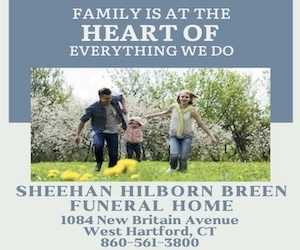
Charter Oak Cultural Arts Center honors those who rescued its building — and, in so doing, its Jewish heritage
By Stacey Dresner
HARTFORD – If not for “COTRA,” the Charter Oak Cultural Center might not exist. And residents of Hartford — including more than 1,300 schoolchildren — might not have access to the kind of diverse and dynamic cultural arts programming the center provides each year.
For that reason, on Monday evening, May 15, Charter Oak will honor several members of “COTRA” — the Charter Oak Temple Restoration Association – with the Jewish Heritage Award during its 16th Annual Vision Awards Gala at the Hartford Marriott Downtown.
Described by event organizers as “courageous, visionary men and women” who in the 1970s saved from destruction the building that originally had housed the Charter Oak Temple, the honorees include Phil Fine, Elliot Ginsberg, Sue Ginsberg Dejuan, Keats Jarmon, Elaine Lowengard, Barry T. Lubin, the late Neal Ossen, Sanford Parisky, Susan Peck, Deanne Shapiro, Louise Spira, Art Vatsky and Joan Walden.
The Charter Oak Temple opened at 21 Charter Oak Ave. in 1876. The home of Congregation Beth Israel, it was the first building in Connecticut to be constructed specifically as a synagogue. Construction had begun on the building only after a law allowing only Christians to own property for formal worship was overturned in 1843. Architect George Keller designed the building in the Victorian-Moorish style. Keller was the architect who also designed the Soldiers and Sailors Memorial arch in Bushnell Park.
When the Charter Oak Temple was built and for many years afterward, Hartford was a thriving city, with a vibrant Jewish community.
“From the turn of the century through the post-war period, Hartford was the place to go,” COTRA honoree Joan Walden told the Ledger.
Still, as with many urban areas, the Jewish community eventually began leaving the city for the western suburbs. Congregation Beth Israel moved to its current building on Farmington Avenue in West Hartford in 1936.
At that time, the Charter Oak building became home to the Calvary Evangelical Church. After the church vacated the building in 1972 it remained vacant and neglected, and was taken over by the Hartford Redevelopment Agency.
Joan Walden, who at the time worked in Hartford’s Downtown Council promoting the arts, was one of a number of people who became involved in saving the building.
She remembers being invited to a Chanukah party at the Prospect Avenue home of Sid and Helen Gardiner.
“They had invited anybody who wanted to come to this party to talk about saving the Charter Oak Temple,” Walden said.
Some of the people at the meeting were descendants of the people who helped to build the old synagogue.
“Somebody stood up and said, ‘We are concerned that this building will no longer be honored.’ So there was this emotional connection,” Walden recalled.
The late ‘70s was a time when there was a burgeoning effort to revitalize Hartford, which had gone through a downturn during the 1950s and ‘60s.
“At that time in history there was a real concern that Hartford was going to lose all of its great old buildings,” Walden explained. “There had been an old YMCA downtown, a gorgeous old Gothic building and it had just been torn down.”
Around the same time, the Hartford Architecture Conservancy was born. This was, Walden said, “a group of people who were very concerned with saving old Hartford.”
And the Charter Oak Temple was one vestige of old Hartford that was in danger of being lost.
“The word on the street was that [Charter Oak Temple] might be sold and there was the risk that it might be turned into a restaurant or maybe they would tear it down,” Walden said.
When Deanne Shapiro heard the news, she was mortified.
“I thought that was horrible. How can you take something of that historic value and that Judaic value and turn it into something else?” she said. “Also my husband and I were looking to become involved in a congregation, but we were finding that the congregations in the area weren’t a good match for us. So we liked the idea of sort of starting from scratch and the idea of an urban Jewish congregation.”
After forming the restoration association, the group found out that since the old temple was listed on the Register of Historic Monuments, they would not be able to hold religious services in the building so forming a synagogue there was out of the question.
“But we remained interested in restoring it as a historical and cultural venue of some kind to preserve the Judaic history, and the freedom of religion and freedom of expression history that it represented,” Shapiro said.
Besides trying to fundraise for the effort, some members of the group got their hands dirty cleaning out the run-down building.
“It was a pretty big struggle because the building was in extreme disrepair…the building had literally been unused and uninhabited for many years except by the rats in the basement,” Shapiro said. “The building was cold, dark and damp. The inside was severely messed up. Windows were missing. It was terrible shape.”
Shapiro and other COTRA members and volunteers swept loads of debris from the building.
“My most vivid memory was the gorgeous chandeliers in crates…and 20 of us, sitting on the floor of the building for hours on end rewiring the chandeliers, fishing electric wire into those armatures under somebody’s direction. Eventually they were able to put them back up again and illuminate the whole building which was amazing.”
COTRA began raising money for the restoration, reaching out to members of the greater Hartford Jewish community, saying, as Shapiro puts it, “Let’s all work together on this, because why would we want part of our heritage to go away?”
Once the building was able to be used, the question was, what exactly would it be used for?
The association’s board wanted the refurbished building to be a “living historical tribute to Judaism and the greater Hartford Jewish community,” Shapiro said. But they also wanted it to become a “showcase for other the arts of other cultures that tended to be underrepresented on the official Hartford art scene.”
Soon many were interested in the beautiful old building and what it could represent to Hartford.
“It seemed to spark a lot of people’s imaginations, not just members of the Jewish community but members of the arts community who were not Jewish, and other benefactors. It just sort of took hold, slowly but surely,” Shapiro said proudly. “So it became a multicultural arts center with a Jewish identity, if you will.”
Rabbi Donna Berman, who has been the longest running executive director of the Charter Oak Cultural Center, praised those who worked so hard to breathe new life into the historic old building.
“We take seriously our responsibility as stewards of this historic building, of this sacred space,” Berman told the Ledger. “We honor its heritage through Jewish programming and through tikkun olam, the work of repairing the world we do every day. We seek to make those who had the courage and vision to save this building proud.”
Shapiro said that she and her fellow honorees are excited to be honored, but more excited that the Charter Oak Cultural Center has become such a mainstay in Hartford.
“It’s just lovely to think that people recognize that this really is something of significance and worth noting,” she said. “Even without the recognition, driving past it and going to events there and just seeing that it is doing what we thought it might do is a tribute in and of itself.”








 Southern New England Jewish Ledger
Southern New England Jewish Ledger








